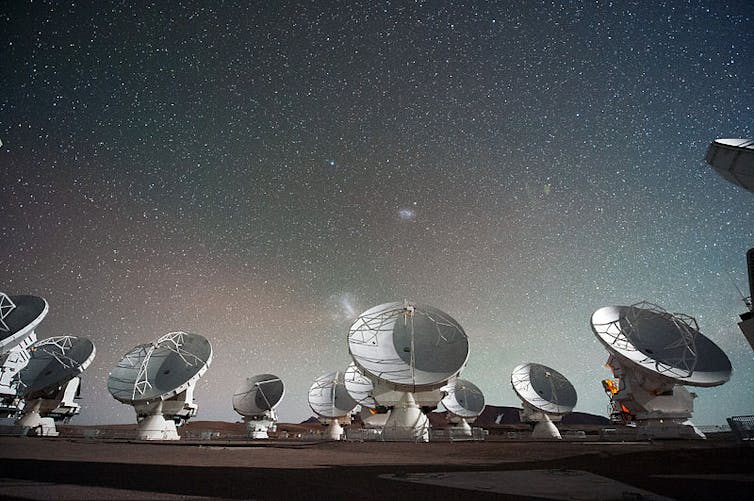Being devoured by a supermassive black hole must surely be one of the scariest ways to go. But we know very little about these cosmic monsters and their feeding process. Despite years of study, astronomers are still learning about how and what they eat in order to grow and evolve.
Simple models of how black holes eat suggest they grow gradually, continually swallowing a steady trickle of the hot gas that swirls around them. Recently, however, theoreticians have started to believe that in addition to this gradual feeding, these objects can also devour whole clouds of cold gas in one sitting. We have now gathered key observational evidence, which has been published in Nature. It shows that supermassive black holes do indeed have huge feasts on cold gas.
Supermassive black holes are everywhere these days – even here on Earth. From the beautiful “Gargantua” in the Hollywood blockbuster Interstellar to the title of a best-selling album by Muse, these enigmatic objects have become touchstones of our culture.
Astronomers have been studying these objects for many years, first as a theoretical concept, and then later in observations. We now know that they lurk deep within the hearts of most galaxies.

When black holes eat, the doomed material collects together into a disc that is heated to millions of degrees before it finally disappears into the inescapable depths of the black hole. The magnetic fields around the black hole also get twisted up within this disc, creating powerful jets of particles. Both the hot material, and the jets glow very brightly in different wavelengths of light, allowing us to spot and study the black hole, despite it not emitting light itself.
Microwave hints
Scattered haphazardly across the Chanantor plateau high in the Atacama desert of Chile lie the 66 antennae that make up the Atacama Large Millimeter/submillimeter Array (ALMA). Each of these dishes, which are technical masterworks in their own right, can be combined with the others in order to create the effect of a much larger telescope. This huge project, involving astronomers from across the world, allows us to detect microwaves emitted from cold objects across universe – such as the clouds which some predict are the preferred food of black holes.

Our team was able to use ALMA to catch a black hole in the act of devouring three of these cold clouds, within the brightest galaxy of a cluster known as “Abell 2597”. This is a tightly knit collection of galaxies located about one billion light years from Earth, in the constellation of Pisces. The central galaxy of this cluster contains a large black hole, weighing in at half a billion times more massive than our own sun, or 100 times bigger than the supermassive black hole at the centre of our own galaxy.
Galaxy clusters such as Abell 2597 build up an extremely hot plasma around them, which some predict can gradually cool and rain down to feed the central supermassive black hole. We know from previous work that the black hole in this object is currently devouring material, so it seemed like an excellent place to look if we wanted to find out what it had on the menu.

To our delight we found the signatures of three cold clouds, backlit against the light emitted from the compact jets around the central black hole. We were able to determine that these clouds are within 350 light years of the black hole itself, and rushing towards it at over 537,000 miles an hour – essentially teetering on the edge of being devoured.
Each of these clouds is around a million times more massive than our sun and thus provides a significant snack, even for a very large black hole. While ALMA was only able to detect these three clouds, there may be thousands like them in the vicinity, which are not backlit by the bright jet. This suggests this particular black hole is ready for a rather large lunch of cold gas, which can fuel its activity for a long time.
The next step, of course, is not just to determine what this black hole eats, but what other supermassive black holes across the universe enjoy. With ALMA we now have a powerful tool that will allow us to do just that. Not only in galaxy clusters, but also in normal galaxies like our own. Only then will we be able to answer the question of what black holes really prefer for lunch.

